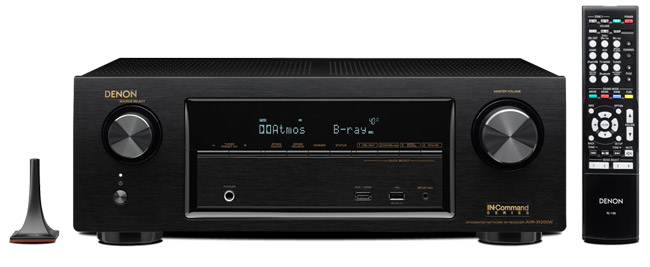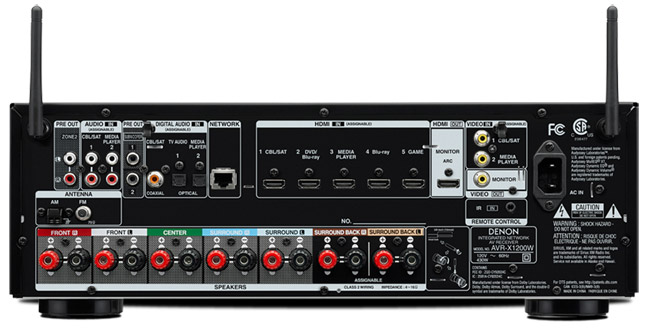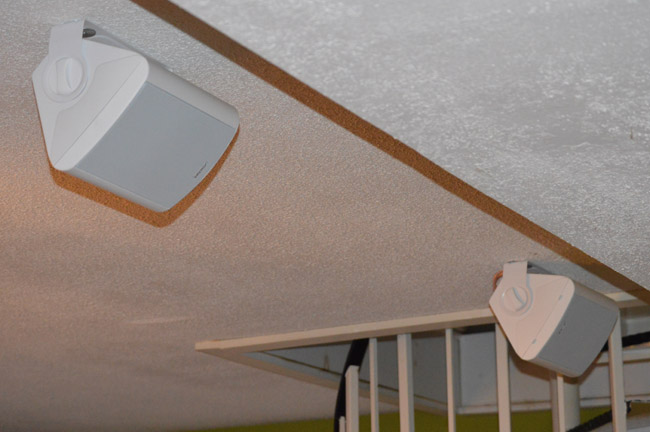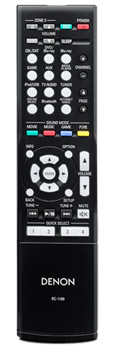
Update: In late 2016, Denon released a firmware update, which added DTS:X support to this receiver. We tweaked this review in December 2016 to reflect the change. See the section labeled "Higher Ground" for more information.
For more than a year, we've been talking about how and why you'd want to have Dolby Atmos in your home. (Find out more about Dolby Atmos here.) So how many of you have actually added that feature into your home theater setup? (A show of hands is not necessary.) If price has been keeping you back -- and really, what else would be? -- Denon Electronics is making it a whole lot easier to upgrade to immersive "3D sound" with the AVR-X1200W.
The AVR-X1200W is an entry-level "7.2-channel" receiver with Dolby Atmos and is upgradeable to DTS:X. They call it "7.2" because it offers seven channels for various speakers plus two subwoofer outputs. Technically calling it "7.2" may be a stretch as the two subwoofer outputs are not independently adjustable in set-up, but for simplicity, we'll go along with the 7.2 nomenclature.
In reality, the AVR-X1200W can support a traditional 5.1 (or 5.2) surround sound system, a 7.1 (or 7.2) surround system, or an "immersive" 5.1.2 (or 5.2.2) channel system. A 5.1.2 system is a standard 5-channel surround system with five speakers surrounding the listener at ear level, plus a subwoofer, plus two height speakers generating sound from above. That's what I set up for testing.
Dolby Atmos and DTS:X are what we call "object-based" audio formats. Instead of assigning all audio to specific channels (left front, right front, left surround, etc.), Dolby Atmos and DTS:X actually treat certain sounds as "objects" that can move virtually anywhere within a hemisphere of sound: left, right, front, back, or even above the listener. This truly puts you in the middle of the action, because it can deliver sound from every angle, including above you. The soundtrack is encoded with these objects during the mix in the sound studio. At playback time, the processor or receiver decodes that object-based mix into the actual speaker channels available on the playback system.
Without a doubt, Dolby Atmos and DTS:X immersive sound are the stars of the show here. However, Denon has packed in some additional kick-ass features, which are pretty impressive for a receiver that can be had for under $600.

The Specs
As I mentioned, at $599 list, the AVR-X1200W is an entry-level receiver (or at most "midrange"), but Denon promises a hearty 80 watts (8 ohm, 20 Hz - 20 kHz, 0.08%THD) for each of its seven channels. Of course, the hook on this receiver is that it will add immersive audio support into your home theater setup. The Dolby Atmos format delivers a 3D-style listening experience, with audio coming at you from just about every angle. However, it's so much more than just plastering a pair of speakers on the ceiling (which you will need to do as well). It creates a lifelike experience that really brings you inside the action. It's basically the closest thing you can get to having actual planes, helicopters, spaceships, and other objects travel across your ceiling.
It should be noted that the DTS:X format can deliver the same type of immersive experience as Dolby Atmos, at least in theory. Denon is planning to add support for that audio format to this receiver through a firmware upgrade. When exactly are they planning to do that? I'm not sure (and neither are they), but I do know that I'm ready now! Until then, we have Dolby Atmos, and I'm not exactly complaining.
So Many Inputs, So Little Time
The AVR-X1200W offers a generous six HDMI 2.0a inputs, so it can accommodate a slew of AV devices, with full support for Ultra HD 4K/60Hz pass-through, high dynamic range (HDR), and HDCP 2.2 whenever you're ready for it. I haven't made the move to Ultra HD just yet, so I didn't do any testing along these lines. But know that this model doesn't upconvert standard or HD content to that 4K resolution (Ultra HD TVs can do that on their own). The receiver also supports 3D pass-through, in case you're a fan. If you want to connect older A/V gear, you'll find two composite video/stereo audio inputs on the back as well as two fiber-optic digital and one coax digital audio inputs.
I will note that this receiver doesn't have component video inputs or a phono input, which is really my only gripe as far as connectivity is concerned. If you're connecting a turntable, be sure to get one with a built-in phono preamp or you'll need to pick up an outboard phono preamp.
Big Sound!
On the audio side, the AVR-X1200W has a quad-core 32-bit DSP processor to decode all sorts of goodies and to perform calibration via the Audyssey Silver suite. This includes Audyssey MultEQ XT, Dynamic EQ, and Dynamic Volume. You'll find support for the full suite of Dolby formats, including Dolby Digital, Dolby Digital Plus, Dolby TrueHD, and Dolby Atmos. On the DTS side, it decodes DTS, DTS-HD High Resolution Audio, and DTS-HD Master Audio with DTS:X decoding promised at some future date. If you're into high-resolution audio, you'll be happy to hear that the X1200 decodes a variety of native high-resolution audio formats, including streaming high-res DSD, FLAC, and AIFF files.
Speaking of the streaming, this model has both built-in WiFi and Bluetooth, as well as AirPlay and DLNA support. Whatever music or audio you want to stream to your home theater, this AVR is pretty darn receptive to it. Users can also access Spotify Connect, SiriusXM, Pandora, and web radio stations without an external device (although subscriptions and/or fees may apply). If you can't seem to stream it, the AVR-X1200W has a front-panel USB port for a quick connection to music files on a local thumb drive.
Other features include multiroom and multisource options for a second room, two subwoofer outputs, Control4 support, and the ability to control the receiver with the Denon AVR Remote app for iOS and Android devices.
As mentioned earlier, if you want to go immersive, the AVR-X1200W supports only two height speakers (5.1.2 or 5.2.2 configuration). While this may be a little light for a large room, this layout worked just fine for my modestly sized living room. In fact, it was better than fine. It was freaking awesome. I will gush more about that in a minute.

Let's Get Fired Up!
At 18.7 pounds, the AVR-X1200W is pretty hefty, but as easy to set up as any other receiver. I appreciated all of those HDMI inputs, since it was easily able to accommodate my Blu-ray player, DISH Hopper DVR, Roku box, and whatever else I have wedged in my AV cabinet, and passed all those lovely pictures along to my plasma TV.
The back is well laid out, but know that those Dolby Atmos height speakers should be connected to the terminals labeled "Surround Back." Since this supports standard 5.1, 7.1, and 5.1.2 layouts, the speaker outputs are multi-purpose and are configured during set up. All of the speaker connections are color-coded, which makes it pretty easy to identify what goes where.
Getting High
In order to go immersive, you will need height speakers, and no, you can't just use those rear-channel surround speakers from a 7.1 system -- at least not without making some adjustments to the position. There are a few options for a 5.1.2 setup. You can get Atmos-enabled "height modules" that sit on top of your front speakers and bounce sound off the ceiling. This can work OK if your room has a nice flat reflective ceiling that isn't more than nine feet high. You can also put a pair of speakers in the front of your room, high on the wall above the main left and right speakers and point these toward the listener. This was how Dolby's old "PLII-z" system worked and this speaker configuration is also supported in Dolby Atmos ("supported," but not "preferred").
The preferred method of doing two height channels in a Dolby Atmos system is to mount the height speakers on the ceiling, in line with the front left and right speakers, just slightly forward of the listening position and pointing down. Dolby says this will give you the best effect from Dolby Atmos in a 5.1.2 (or 5.2.2) configuration. You can read more about Dolby's specific recommendations for Atmos at home in the Dolby Atmos home speaker setup guide. This is how I configured the speakers in my 5.1.2 system.
In terms of specifics, I added a pair of Energy's Take Classic white indoor/outdoor speakers on the ceiling just above and in front of the couch. These were an excellent tonal match to my existing Energy Take 5.1 Classic system and the white color of the ceiling speakers makes them fairly unobtrusive on the ceiling. All in, this entire 5.1.2 channel speaker system can be had for under $500 street price and makes a great match for the Denon receiver. You can get them here on Amazon:

And Now Back to Our Regularly Scheduled Receiver Review
The front panel of the AVR-X1200W has a source knob, a volume knob, and buttons for flipping between presets on the tuner, zones and zone sources, and all of the main room A/V sources. There's also a headphone jack, as well as a front-panel HDMI jack and USB port. There's even a little mini plug specifically for the "Setup Mic." Chances are, you will only have to use this jack once, but it's one of the most important ports on the entire component.
That jack will hook you up with the built-in Audyssey sound calibration, which will optimize your speaker settings for your specific room. This is a wonderful thing. To start the process, you'll need to plug the calibration microphone into that jack on the front. Denon has included the mic and a cardboard tripod in the box. The tripod is important, because you don't want to be yelling or even breathing heavily into the microphone while it's trying to take measurements. Also, since the tripod is adjustable, you can tweak the height to get the microphone to the level where you'll be doing most of your listening. From there, the receiver's remote and the on-screen assistant will guide you through the whole calibration process. It's extremely painless. In fact, that same on-screen setup assistant can guide you through other receiver setup options as well.
Once the setup and calibration is completed, you can marvel at the finished product -- or at least the front panel of the AVR-X1200W. The screen is nice and big, making it pretty easy to read from across the room. It can deliver a lot of information about what's coming through the receiver, including the source and input mode, the audio format being delivered, whether audio signals are being output from the surround back speakers, and more.
Higher Ground
Did I mention that the AVR-X1200W supports Dolby Atmos? I really can't say it enough times. It's a pretty fantastic thing to have at home. It's like being at a premium movie theater, but without the loud patrons and sticky floor.
And adding that Dolby Atmos into the home couldn't be much easier than it is on the AVR-X1200W. I say that because this unit offers a pretty pain-free setup and it can be had for a mere $599 (MSRP). Right now, there's a growing list of Dolby Atmos Blu-rays out there. It's not a huge collection, but it was enough to get me addicted to the format while testing out this unit. It made some scenes a lot more memorable and in some cases, made movies more enjoyable. That sandstorm scene in American Sniper, the destruction in San Andreas, the whipping winds in Everest, and the general mayhem of Mad Max: Fury Road are just a few of the standout Dolby Atmos moments you really need to experience to understand just how cool this format can be.
Update: In December 2016, I ran a firmware update and behold... the AVR-X1200W now includes support for the DTS:X audio format. The company had previously been upgrading some of its higher-end (and higher-priced) receivers in both the Denon and Marantz product families, but I'm thrilled to see that they didn't forget about us cheap-Os. This is a huge perk for this price, since it now means that this receiver is compatible with Dolby Atmos and DTS:X-enhanced Blu-rays. Not sure I will be popping in The Last Witch Hunter or London Has Fallen anytime soon, but the upgrade was much appreciated when I reviewed Jason Bourne. This Blu-ray is worth picking up just for the audio track. It has a surprising amount of overhead effects, all of which sounded awesome through the AVR-1200W. For a complete list of DTS:X-enhanced Blu-rays, check out "Which Blu-ray and 4K Ultra HD Blu-ray Discs Have DTS:X."
If I'm going to gripe (again), it's because there's no way to upgrade this receiver to 5.1.4 sound (4 height channels). Some manufacturers make upgrading an option using an external 2-channel amp. Yes, you could buy a 9-channel receiver, but you'd also need to buy a whole new receiver and trash this little beauty. Then again, at this price point, no one is doing four height channels (even with an external amp), so take this criticism with a grain of salt.
All Your Other Audio
Even when I wasn't ducking for cover, the AVR-X1200W was a lot of fun to use in my home theater. Other movies, TV shows, sports, and everything we watched on a daily basis looked and sounded good. The unit adapts to whatever format is being broadcast, so you never have to be flip-flopping with a remote. The image was always clear and the audio always sounded wonderful. I have zero complaints about the performance. However, if you think the surround sound is getting overwhelming (as I found sometimes with broadcast TV late at night), tapping the Sound Mode buttons will bring up options that allow you to kill off some of the speakers (and bring them back, of course). And if you like sound coming from above, just keep the receiver in "Dolby Surround" mode. This uses Dolby's proprietary "upmixing" technology to simulate height channels from 5.1, 7.1, or even 2-channel source material.
Music was just as pleasurable as movies -- and plentiful, thanks to this receiver's many connectivity options. While it's great that the AVR-X1200W has an Ethernet port around the back, you will probably never use it. Seriously. This thing has so many other ways to connect to the web and web-enabled devices. I never had problems upgrading software through WiFi or streaming music using Bluetooth or AirPlay. What I did do was enjoy music from a variety of sources, since there were so many ways to enjoy it.
The AVR-X1200W can deliver SiriusXM and Spotify Connect without any extra hardware, if you have a subscription. I do not. However, I was able to conjure up my Pandora account and rock out to a few custom Pandora radio stations. These days, I am slightly addicted to Apple Music, so I spent a lot of time streaming that from my iPad using both AirPlay and Bluetooth. There is a slight lag with each one, but it's literally 1-2 seconds and barely worth mentioning.

Get in Control
As with many of today's receivers, there are several ways to control the AVR-X1200W. Basically, you can choose whichever way you like to control it, be that via the receiver's factory remote, Denon's smartphone app, or a third-party remote. My family typically gravitates towards our DISH Network remote, but we also added the Denon receiver into our Logitech Harmony Elite remote. The latter offered a few more of the bells and whistles that you'd find on the included factory remote.
But for testing purposes, I used the remote that came with the receiver -- a lot. Overall, I was really pleased with the layout and functionality that it offered. This receiver has a lot of options, but the remote never seemed overwhelming. As with most remotes, you're probably not going to use all of the buttons here... at least, not every day. However, everything is laid out really well and doesn't require much of a learning curve.
If you're addicted to smartphone control, the AVR-X1200W is also compatible with Denon's 2015 AVR Remote iOS and Android apps.
Turn-Ons:
Turn-Offs:
Honestly, I found myself straining to find multiple "turn offs" for the Denon AVR-X1200W. It's a great little receiver -- and perfect for people looking to make the leap to Dolby Atmos and DTS:X immersive surround sound. There are a few cheaper options out on the market now, but this has a pretty hearty list of features for just a few extra bucks. Empty out that piggy bank and enjoy. But you can't have my review sample, because I already bought it.
Manufacturer's Specifications:
Company Contact Information:
Denon Electronics (USA)
100 Corporate Drive
Mahwah, NJ 07430-2041
On the web: usa.denon.com/us
Where to Buy:
| Overall | |
|---|---|
| Value | |
| Performance | |
| Features/Ergonomics |